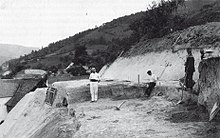Josef Bayer (archaeologist)
Josef Bayer (born July 10, 1882 in Hollabrunn , Lower Austria , † July 23, 1931 in Vienna ) was an Austrian anthropologist and prehistoric archaeologist .
Life

Bayer was director of the Prehistoric and Anthropological Collection of the Natural History Museum in Vienna and founded the Institute for Ice Age Research . Founder and editor of the specialist journal Eiszeit (and prehistory). His research areas mainly concern the Stone Ages and especially the Paleolithic . He developed his own model of the Ice Age. Bayer was not only active internationally, but also conducted research in the local area, for example in the Waldviertel and above all in the Wachau . He promoted local researchers of the rank of Josef Höbarth .
He was the leading Austrian prehistoric scientist of his time, and his results and thought-provoking impulses continue to point the way up to the present day. Worth mentioning are - among many others - excavations in the Upper Palaeolithic station Kamegg and in the Neolithic Silex mining area on the Antonshöhe in Mauer near Vienna . In 1908 the discovery of Venus von Willendorf , in which he was involved, caused a sensation . From 1908 he was also a correspondent for the kk Central Commission in Vienna. As part of his military service in World War I, he was a. a. Moved to Palestine and used the time for archaeological research, during which he discovered what he called the Ascalon culture .
Fonts (selection)
- The Chronology of the Younger Quaternary. In: Communications of the prehistoric commission of the quays. Academy of Science. Vol. 2, H. 2, 1913, pp. 199-227.
- The mammoth hunter stop of the Aurignac period near Lang-Mannersdorf ad Perschling (Lower Austria). Preliminary report on the 1919/1920 excavation. In: Mannus . Vol. 13, 1921, pp. 76-81.
- with Heinrich Wichmann: The Frauenlucken near Schmerbach in the upper Kamptale, a cave station of the Magdalenian in Lower Austria. In: The Ice Age. Vol. 1, 1924, ISSN 0259-773X , pp. 65-67.
- Man in the Ice Age. Deuticke, Leipzig et al. 1927.
- An ice age hunter's station in Mießlingtal near Spitz ad Donau in Lower Austria. In: The Ice Age. Vol. 4, 19274, pp. 91-94.
- The first bell beaker from Austria. (Groß-Weikersdorf, Lower Austria). In: Communications from the Anthropological Society in Vienna . 57, 1927, pp. 51-52.
- Young Bronze Age graves near Baierdorf, pol. District Hollabrunn, Lower Austria. In: Communications from the Anthropological Society in Vienna. 61, 1931, pp. 209-212.
- The prehistoric and early historical man on the soil of the Horner district. In: Franz Lukas, Friedrich Moldaschl (Hrsg.): Heimatbuch des Bezirk Horn. Volume 1. Josef Pichler (on commission), Horn 1933, pp. 180–240.
literature
- Friedrich Wagner: Bayer, Josef. In: New German Biography (NDB). Volume 1, Duncker & Humblot, Berlin 1953, ISBN 3-428-00182-6 , p. 678 f. ( Digitized version ).
- Bavarian Josef. In: Austrian Biographical Lexicon 1815–1950 (ÖBL). Volume 1, Verlag der Österreichischen Akademie der Wissenschaften, Vienna 1957, p. 59.
Web links
- Literature by and about Josef Bayer in the catalog of the German National Library
- Klaus Taschwer: witch hunt against the co-discoverer of Venus von Willendorf. The standard of September 30, 2017.
Individual evidence
- ↑ Person encyclopedia of the Federal Monuments Office
- ↑ Dietmar Grieser : Hidden Fame. Austria's secret genius. Amalthea, Vienna 2004, ISBN 3-85002-508-X .
| personal data | |
|---|---|
| SURNAME | Bayer, Josef |
| BRIEF DESCRIPTION | Austrian archaeologist |
| DATE OF BIRTH | July 10, 1882 |
| PLACE OF BIRTH | Hollabrunn , Lower Austria |
| DATE OF DEATH | July 23, 1931 |
| Place of death | Vienna |

